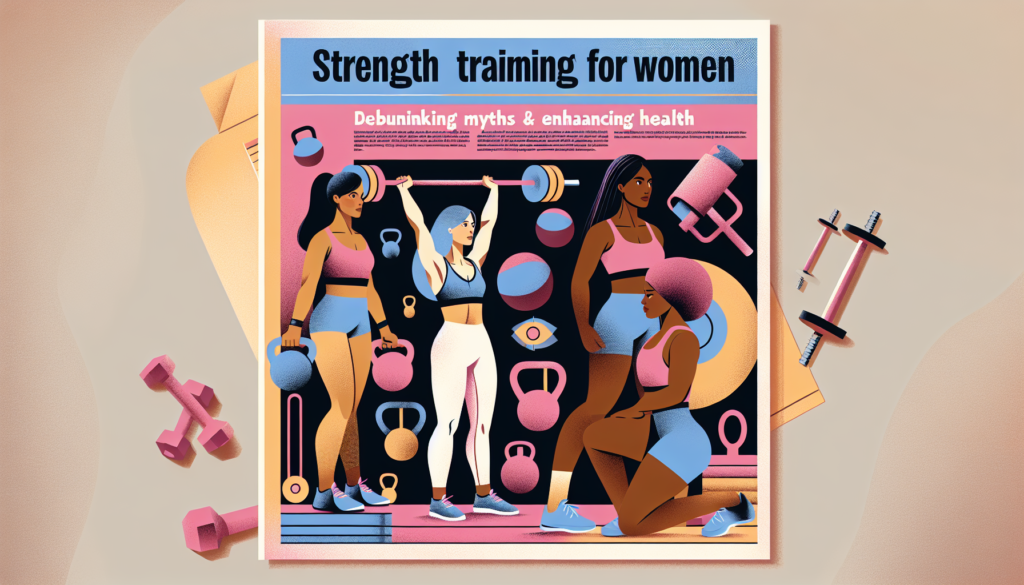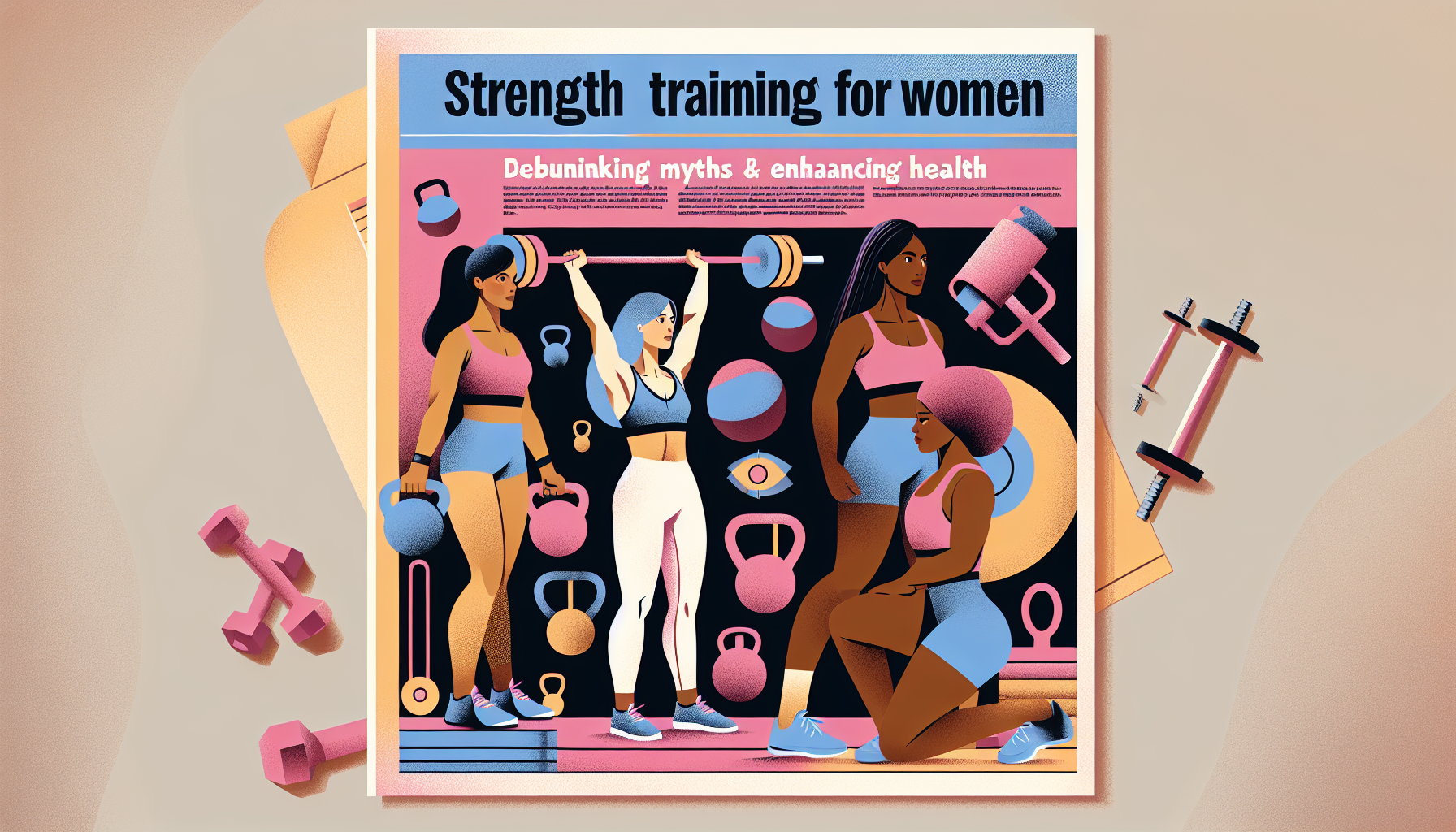So, you’ve decided to take your fitness journey to the next level and incorporate strength training into your routine – good for you! But if you’re new to this whole strength training thing, it can feel a bit overwhelming and intimidating. That’s why we’ve got you covered with the Beginner’s Guide to Strength Training for Women. In this article, we’ll break down the basics of strength training, dispel common myths, and provide you with practical tips on how to get started. By the end of this guide, you’ll feel empowered, confident, and ready to crush your fitness goals.

Benefits of Strength Training for Women
Strength training offers a multitude of benefits that are especially advantageous for women. One of the most notable advantages is the increase in muscle strength and tone. By incorporating strength training into your fitness routine, you can sculpt and define your muscles, resulting in a more toned and athletic physique.
Additionally, strength training can significantly boost your metabolism and aid in weight loss. Unlike cardiovascular exercise, which primarily burns calories during the activity, strength training continues to burn calories even after your workout is complete. This is due to the fact that building muscle increases your resting metabolic rate, allowing you to burn more calories throughout the day.
Another key benefit of strength training for women is the improvement in bone density. As women age, the risk of osteoporosis becomes a concern. However, engaging in strength training exercises can help combat this by stimulating bone growth and reducing the risk of fractures. By adding resistance to your workouts, you are effectively strengthening your bones and promoting overall bone health.
Furthermore, strength training enhances your overall physical performance. Whether you’re a runner, a cyclist, or simply want to improve your day-to-day activities, strength training can make a significant difference. By improving your muscular strength and endurance, you’ll find that tasks such as carrying groceries or climbing stairs become easier and more manageable.
Setting Realistic Goals
Before embarking on any fitness journey, it’s essential to understand your personal fitness level. Taking the time to assess your current capabilities will not only help you set realistic goals but also provide a starting point from which to track your progress. This self-awareness is the key to designing an effective workout plan tailored to your individual needs.
Once you have a clear understanding of your current fitness level, it’s time to identify specific goals. Whether your objective is to build strength, increase muscle mass, or improve overall fitness, setting clear and achievable goals will keep you motivated and focused. Remember to be realistic with yourself, considering factors such as time commitment, lifestyle, and physical limitations.
Creating a timeline for achieving your goals is crucial to staying on track. By breaking down your goals into smaller, manageable steps, you’ll be able to track your progress more effectively. This not only ensures that you stay motivated but also allows you to celebrate each milestone along the way.
Choosing the Right Equipment
When it comes to strength training, choosing the right equipment is essential to achieving your goals efficiently and safely. Depending on your preferences and access to facilities, there are various options available.
Dumbbells and resistance bands are versatile and great for beginners. They offer a wide range of resistance options and can be used for both upper and lower body exercises. Barbells and weight machines are more advanced options, as they require a higher level of technique and can provide heavier resistance. Functional training equipment, such as kettlebells and medicine balls, allow for dynamic movements and can add an extra challenge to your workouts.
Consider your comfort level, experience, and available resources when selecting the equipment that suits your needs best. Remember, proper form and technique are crucial, so it’s important to familiarize yourself with each piece of equipment before incorporating them into your workouts.
Getting Started with Proper Form
Mastering basic bodyweight exercises is a great starting point for strength training. Exercises such as squats, push-ups, and planks can be done anywhere and require no additional equipment. By focusing on maintaining proper form and engaging the correct muscles during these exercises, you’ll develop a solid foundation for more advanced movements.
Learning proper lifting techniques is crucial to maximize the benefits of strength training while minimizing the risk of injury. Start with lighter weights and focus on mastering the correct form before gradually increasing the resistance. This not only ensures proper muscle activation but also prevents strain and injury.
Engaging the correct muscles during each exercise is essential for targeting specific muscle groups effectively. Take the time to understand which muscles are being worked in each exercise and concentrate on activating and engaging them. This mind-muscle connection will allow you to get the most out of your workouts and achieve better results.

Designing an Effective Workout Plan
When designing a strength training workout plan, there are several factors to consider. One of the first decisions to make is whether to follow a full-body workout or split routines. A full-body workout targets all major muscle groups in one session, while split routines focus on specific muscle groups on different days. Both options have their benefits, so choose the one that aligns with your goals, preferences, and schedule.
Selecting the appropriate exercises for each muscle group is key to achieving a well-rounded and balanced physique. It’s essential to include exercises that target all major muscle groups, such as squats, deadlifts, lunges, bench presses, and rows. This ensures that you are working all areas of your body and developing strength in a comprehensive manner.
Progressive overload is the principle of gradually increasing the intensity and workload of your workouts to continue challenging your muscles. This can be achieved by increasing the weight, repetitions, or sets. By implementing progressive overload, you’ll ensure that your muscles are consistently being stimulated, leading to continuous growth and improvement.
Warming Up and Cooling Down
Before diving into your strength training session, it’s crucial to warm up your muscles and prepare your body for the workout ahead. Dynamic stretching, which involves actively moving and stretching the muscles, is an excellent way to warm up. Perform exercises such as arm circles, knee raises, and leg swings to increase blood flow, improve joint mobility, and enhance muscle elasticity.
In addition to dynamic stretching, incorporating mobility exercises is essential for promoting joint health and range of motion. These exercises target specific areas of your body and aim to improve flexibility and movement. Focus on areas that are commonly tight or prone to stiffness, such as the hips, shoulders, and spine.
After completing your strength training session, it’s equally important to cool down and stretch your muscles. Foam rolling, a form of self-myofascial release, can help alleviate muscle tension and prevent soreness. Additionally, static stretching, where you hold each stretch for a prolonged period, helps improve flexibility and reduce muscle stiffness.
Managing Rest and Recovery
Rest days are an integral part of any strength training program. While it may be tempting to push yourself every day, proper rest and recovery are essential for muscle growth and injury prevention. Overtraining can lead to fatigue, decreased performance, and an increased risk of injuries.
Incorporating active recovery exercises, such as gentle yoga, swimming, or walking, on rest days can help promote blood flow and reduce muscle soreness. These low-intensity activities allow your body to recover while still staying active and mobile.
Proper nutrition and hydration are also crucial for optimal rest and recovery. Fueling your body with adequate nutrients, including protein for muscle repair and carbohydrates for energy, will support your muscles’ growth and recovery. Hydrating before, during, and after workouts helps maintain proper muscle function and prevents dehydration.
Tracking Progress and Staying Motivated
Keeping a workout journal is an excellent way to track your progress and stay motivated. Write down the exercises you perform, the amount of weight lifted, and the number of repetitions and sets completed. Tracking your progress allows you to see how far you’ve come and provides a sense of accomplishment. Additionally, it can help you identify areas of improvement and set new goals.
Fitness apps and tracking devices can also be valuable tools in tracking progress and staying motivated. These apps allow you to log your workouts, monitor your progress, and set reminders for upcoming workouts. Many apps even provide pre-designed workout plans and video demonstrations of exercises.
Finding a support system and setting rewards for achieving milestones can help keep you motivated throughout your strength training journey. Share your goals with friends or family who can provide encouragement and accountability. Additionally, treating yourself to small rewards, such as a new workout outfit or a massage, can serve as a great incentive to stay on track.
Preventing Injury
Avoiding overtraining is crucial to prevent injuries and maintain a sustainable strength training routine. Listening to your body and recognizing the signs of overtraining, such as excessive fatigue, difficulty recovering, and decreased performance, is essential for injury prevention. If you suspect overtraining, be sure to allow yourself extra rest and modify your workouts accordingly.
Using proper form and technique during exercises is one of the most effective ways to prevent strain and injury. Take the time to learn the correct form for each exercise and focus on maintaining it throughout your workouts. If you’re unsure about proper technique, consider working with a certified personal trainer who can guide and correct your form.
Flexibility and mobility exercises play a significant role in injury prevention by improving joint stability and range of motion. Incorporating exercises such as yoga, Pilates, and stretching routines into your routine can help maintain flexibility and prevent muscle imbalances. Additionally, focusing on mobility exercises specifically targeting areas prone to tightness, such as the hips and shoulders, will further reduce the risk of injury.
Conclusion
Strength training offers numerous benefits for women, from increased muscle strength and tone to improved bone density and overall physical performance. By setting realistic goals, choosing the right equipment, and getting started with proper form, you can embark on a successful strength training journey. Designing an effective workout plan, incorporating warm-ups and cooldowns, managing rest and recovery, and preventing injuries will further optimize your progress. By tracking your progress, staying motivated, and taking steps to prevent injury, you’ll build strength, confidence, and a healthier lifestyle. So, grab those dumbbells, set your goals, and start reaping the many rewards of strength training!
